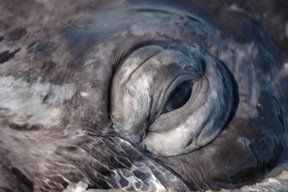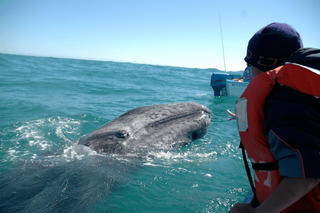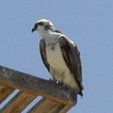Gray whale watching in Baja
When on the ground we travel in our 15 passenger vans or in the 8 seat Suburban. The desert scenery
is very special. Rock gardens, enormous cactii and some of the cleanest
air you may ever have the chance to breathe.
The adventure begins when we leave
the Holiday Inn - Bayside in San Diego before the crack of dawn. Our
early start ensures that we will not get stuck in morning rush hour
traffic. The
border is
30 minutes away.

We cross the border around 5:30 AM. The
sky is still black, but the border crossing at Tijuana is brightly lit.
Coming north is a huge stream of traffic that seems to have no
end. On
the way north we take a slight detour inland and cross back into the
USA at the border town of Tecate, famous for the beer that is brewed
there, thus avoiding this busy border crossing.
If you've chosen to stay in town while in gray whale watching, La Posada De Don Vicente has been our
Guerrero Negro room provider since 1996. We usually arrive at the
hotel in the afternoon between 5 and 6 PM Central time zone. Dinner
will be eaten at a nearby restaurant and then most of the group will
be sound asleep by 9 or 10 PM. Since we've opened our upscale seaside safari camp, almost every guest has chosen to stay there where dinner will be eaten in our dining tent.
In the morning we eat breakfast at the Puerto Viejo
Restaurant each morning at 7:00 A.M., or in our dining tent for those staying in camp.
Our early morning arrival at the
shore is planned to take advantage of the normally calm mornings. If you're staying in camp, the whale watching began as soon as you walked out of your tent, but these are just a bonus, the whale watching from the boats is what is going to get you an up close experience.
We are a small group adventure company
with normally 10 up to 20 in a whale watching group, with the average
size of around 12. To the right a young adult whale plays with
our group of 8.

Experience does count when you are traveling
to remote and rugged locations. Baja Jones has been driving groups
to Laguna Ojo de Liebre since 1994. Once in a lifetime vacations
should not be left to chance.
Of course we LOVE baby gray whales. You
will likely see dozens of them during your 5 day adventure. Sometimes you notice what appears to be the same whale on different days of the trip, we identify
gray whales by scars and other oddities.

This is a 4 year old Osprey who tried to
take up residence on the platform we erected in our yard in Guerrero Negro,
but he finally decided to use it only for a feeding platform when the females
all shunned his mating cries from here
We arrive at the shore of Laguna Ojo de
Liebre around 9:00 A.M. Our ride from the hotel to the lagoon is
around 15 miles on a dirt and salt road that skirts the edge of the lagoon. Ours
was the first vehicle to drive on the road this morning so we were fortunate
to catch a glimpse of two coyotes fishing in a tide pool on the edge
of the marshland. Osprey are common here. As we approached
the embarkation spot I pointed out the many whale spouts that are visible
from the road. That morning I am sure I could see between 50 and
100 whales within view of the embarkation point.

Patti, from Minnesota, is our most experienced
guide. Patti is a highly skilled scuba diver
who has dived in more places than we have room to list. (she is wearing the red hat)
Laying hands on a wild and free 40
foot adult whale is an experience you must feel to understand.
When a whale tail shows like this, I
like to say she is waving goodbye. This photo was taken near the
entrance where the water is deeper and allows whales to dive and breach
easily.
The tail to the left and the photo
below are from two different mating groups. This tail was
not a whale diving, but rather he was doing a headstand.
If you look closely at the spyhopper
to the right you can see the eye just visible above the water line.
As the name spyhop implies, most whale watchers believe that the
whales are looking at us. Not so in most cases of spyhopping. Usually
the eye does not come out of the water during the spyhop maneuver. Join
us in Baja to find out more about spyhopping.
The photo to the right illustrates
one of my favorite types of whale encounters. When we experience a
whale
like this, we don't usually get to touch him because they lay beneath
our boat, just inches out of touching range.
To the left is a mating male who rolled
over onto his back as he dived after the female. Baja Jones clients
see more mating activity than usual because we know what to look for
and how to find the mating groups if they are present.
